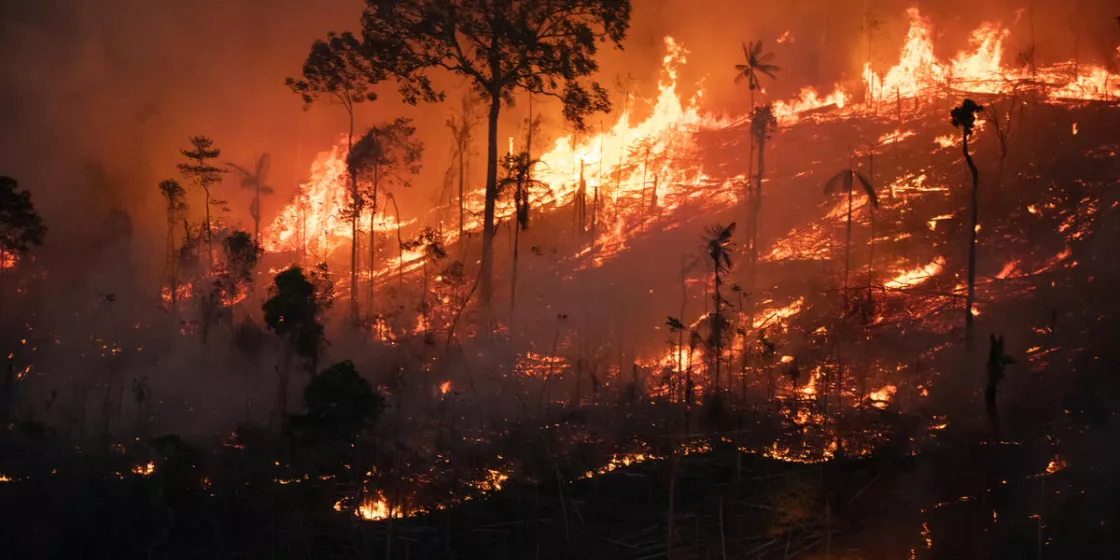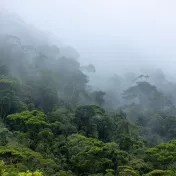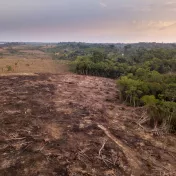Climate tipping points are thresholds in the Earth’s climate system. When passed, this system experiences abrupt and typically irreversible changes. Over the past decade, there has been a rapid evolution in research around these tipping points, and we now know that some could be crossed over the coming decades, dramatically worsening an already dangerous climate situation.
With tipping points, small, gradual changes—global temperature increases, for example—can result in strong, fast, and extreme responses in the system. The effects, which can range from temperature increases, changes in precipitation patterns, increased storminess, flooding, and drought, go above and beyond those already predicted in climate change scenarios.
These changes will wreck the lives of countless millions of people, especially in the most deprived areas of the world. Livelihoods will vanish, homes will be rendered uninhabitable, communities will be sundered, and people will die. This growing threat has led to calls for immediate political action to reduce global greenhouse gas emissions and help the most vulnerable prepare for a more hostile climate.
In this blog series, we take a look at four of the most treacherous tipping points: the Amazon rainforest, the Atlantic Meridional Overturning Circulation, Coral Reefs, and the West Antarctic Ice Sheet. We also provide an overview of their physical nature and their impact on human security, including the important issue of loss and damage, a topic which became a major discussion point at COP27.
Nearly two million acres of the Amazon rainforest burned in November 2022, an increase on the same time a year earlier, which is surprising in a month coinciding with the rainy season. That’s according to MapBiomas, an NGO consortium composed of nonprofits and Brazilian universities who use satellite imagery to monitor the destruction of natural environments. They suggest that the surprising uptick in forest clearing during the rainy season—coinciding with the final months of Bolsonaro’s term—is a response to fears that anti-deforestation policies will prevail under the next government. Fighting against deforestation had been a major part of the election campaign of newly inaugurated leftist president Luiz Inacio Lula da Silva.
It’s hard to imagine another climate tipping point that is more impacted by the nature of polarised short term politics than that of the Amazon rainforest. The very fate of this rainforest, and the quality of life for all the tens or hundreds of millions of people who rely on it, could be in the hands of a single politician.
In total, including November's numbers, the area burned in the first 11 months of 2022 totaled around 40 million acres, almost the size of Uruguay. Fires and other forms of deforestation increased after populist Brazilian president Jair Bolsonaro took office in 2019. Bolsonaro has long been an advocate for expanding farming in the region. But this is just a contemporary instance of policy which goes back well into the 20th century, including the development of the Trans-Amazonian Highway built by the Brazilian military dictatorship in the 1970s.
In addition to the extraordinary—and hellish to witness—biodiversity loss that the deforestation of the Amazon causes, local changes experienced there due to global heating are set to have extraordinary regional and global effects in years to come. In particular, the Amazon rainforest is considered a climate tipping point because it may shift to a savannah or savannah-like environment given enough tree death. In this blog post, we will discuss the effects of deforestation, climate change, and the potential threat that crossing this climate tipping point will have on the region—and indeed elsewhere—and take a deep dive into the human and socio-economic impacts.
Importance for climate
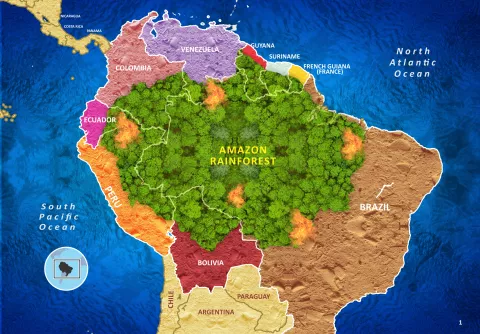
The Amazon rainforest covers most of the Amazon basin across the South American continent, with the majority in Brazil, and extending into Peru, Colombia, Bolivia, Ecuador, French Guiana, Guyana, Suriname, and Venezuela. Thought to exist for some 55 million years, the rainforest is also host to a large biodiversity. Approximately 10% of the known species on Earth are located there—including an estimated 400 billion individual trees, across 16,000 species—much of which is at risk in a so-called dieback scenario. Moreover, 30 million people live in the region, an estimated 10% of whom are in indigenous populations.
The Amazon is important as a component of the Earth’s climate system for a variety of reasons. Chiefly, it acts as a carbon sink, absorbing carbon dioxide into the trees and plants that make up its huge biodiversity. Storing somewhere between 150 and 200 gigatonnes of carbon, the rainforest has historically been an important sink for human carbon emissions. Hence, any dieback of the forest would result in a reduction of its ability to store carbon. Indeed, this sink has declined since the latter half of the 20th century and, by some reports, up to 20% of the Amazon forest has been lost to deforestation since the 1970s. Policies introduced by the populist Bolsonaro government in 2019 have since even accelerated this rate.
In addition to the problem of deforestation, a combination of a climate change-induced drying trend along with unprecedented droughts, has led to mass tree mortality. In fact, in recent years, evidence has been gathered which suggests that the rainforest has turned from a carbon sink to source. This provides a positive feedback on carbon dioxide concentrations globally, acting to increase them—with implications for global climate. Have a think about that. It means that the Amazon is now a net carbon emitter.
Continued loss of the Amazon rainforest would also cause a strong reduction in rainfall in the region which would have drastic impacts for food security. Furthermore, it would change flood and drought patterns, affecting the livelihoods of hundreds of millions of people. That’s because as trees are lost through deforestation and anthropogenic dying, less water is transpired from their leaves, culminating in less water moisture in the regional atmosphere. As rainfall further decreases in the area, the trend towards further dying grows and the potential for a turn towards a more savannah-like environment develops.
Amazon as a tipping point
The Amazon is a proposed tipping point precisely because large regions are at risk of becoming savannah, a largely irreversible process resulting in the rainforest becoming a carbon source rather than sink. According to a 2022 study published at Research Square, ‘under ongoing global warming, the frequency of severe droughts such as in 2005 and 2010 is projected to increase strongly, up to the point where these droughts may become the new climate normal in the second half of this century.’
The study also highlighted that ‘nonlinear thresholds in the hydrological balance of the rainforest might be exceeded under drier future conditions.’ That essentially means that an Amazon tipping point may be reached due to changing rainfall patterns, especially decreasing rainfall amounts. Other studies have shown that large parts of the Amazon rainforest have been losing resilience thus far this century. These problems are compounded by the ongoing deforestation, which is a political issue. Indeed, already by 2018, about 17% of the Amazon rainforest had been destroyed. Research suggests that upon reaching about 20–25% (that is 3–8% more) the tipping point to flip the rainforest into a non-forest savannah will be reached.
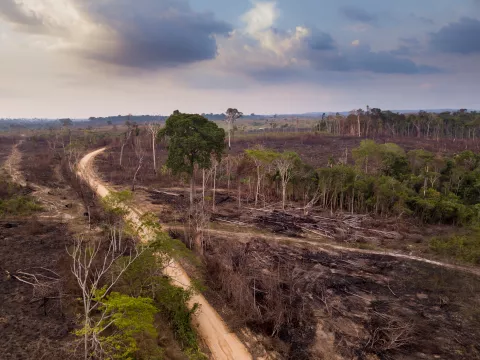
The question, then, is: when will the Amazon tipping point be reached? There is general consensus that this will be triggered relatively soon. Where exactly the critical, non-linear threshold is in terms of forest volume is an open research question.
According to another research published in 2022, this tipping point is possible beyond 2°C above pre-industrial global mean temperature (we are already 1 degree above). It provides a range of values between 2°C and 6°C above pre-industrial global mean temperatures, with a best estimate at 3.5°C. That’s independent of deforestation, meaning the temperature threshold for tipping the Amazon is very likely lower and coming sooner. Depending on future emission scenarios and deforestation policies in the region, this would imply that the threshold could be crossed somewhere in the next 50 - 200 years.
Crossing this tipping point will not only result in enhanced drought across large regions of Brazil and South America, with major impacts for agriculture and human life, but also in a global feedback. By increasing global mean surface temperatures by up to 2°C, it will further exacerbate global heating and help set in motion a cascade of other tipping points.
Socioeconomic impacts, loss and damage, and human security
So we know that crossing the Amazon tipping point will mean tremendous environmental changes. What we don’t know enough about is how people will be impacted by this. As environment-economy modellers Banerjee et al. state, ‘[literature] that assesses the economic impacts of a tipping point [in the amazon] and policy interventions to avert one is scarce’. Moreover, most studies focus on the overall cost of an Amazon dieback (cf. 1, 2, 3). We thus have plenty of large, rather abstract figures that must be put into context, but much less in the way of concrete harms.
Vulnerability
Let’s start by assessing the vulnerability of those likely to be affected by the Amazon tipping point. Much of the immediate insecurity comes from the relative poverty of the Amazon region and its therefore limited capacity to adapt.
Together, five of the Amazon states—Brazil, Columbia, Ecuador, Bolivia, and Peru—amass 70% of their GNP from agribusiness, hydropower, and heavy industry. The rainfall the Amazon generates is crucial to these industries, and thus the livelihoods of countless Latin Americans. The region lost around 0.2% of its GDP between 1996 and 1999 to wildfires, which are expected to occur with far greater rapidity as the tipping point is approached. In addition, commercial fisheries in the region achieve an annual catch valued at US$389 million per year. More frequent droughts and increased erosion threaten this industry as they destroy and poison the habitat of the fish on which it depends.
The group most vulnerable to deforestation are the indigenous people living in the Amazon rainforest and depending on forest resources for food, fuel, and housing. For example, fish are a basic staple of diets in the Amazon and their increasing scarcity poses a threat to many Indigenous Peoples in the region.
General impacts
To examine the costs, let’s begin with the most significant type of study, even if it lacks intuitive appeal. This is the large-scale, abstract study that attempts to boil down the losses from crossing the tipping point to one number. These feed directly into carbon pricing and national accounting and tend to feature prominently in IPCC reports. While essential, these sorts of studies have a big drawback: they lack detail, especially about the human costs. This limits their ability to communicate the problem. It also means they are likely to be inaccurate, resting on assumptions rather than granular data. We will discuss a few recent efforts.
We should begin with Dietz et al.’s controversial study - also discussed in our blog post on the Atlantic Meridional Overturning Circulation - which finds that the loss of the Amazon will come at only a minor economic cost. We should note that this study includes only the loss of the forest’s contribution to reducing CO2 in the atmosphere, which perhaps explains why the number is so low.
An alternative effort by Banjeree et al., published in late 2022, looks at the impact regionally, and finds the sum of 3% of regional GDP. Lapola et al., looking at just Brazil, judge the costs to range between US$957 billion and US$3,589 billion, which is probably an even higher proportion of GDP. In 2009, Lenton, Foottitt, and Dlugolecki, calculating global losses, submitted that as much as US$9.4 trillion was potentially at risk, which is difficult to compare, but is probably lower.
The differences between how these numbers have been produced are manifold. Estimates can differ significantly depending on whether one is counting regionally or globally, what is being counted as ‘the Amazon’, whether one is looking at wealth or just GDP, what ecosystem services are being counted, and so on. When it comes to global estimates, however, we should bear in mind that, barring a transformational improvement in aid delivery, most of the costs will fall on the region. What may seem a small proportion of global wealth may well be a major proportion of regional wealth. Much more research needs to be done to tease out these headline economic impacts. At the moment, it is difficult to state the economic worth of the Amazon with any confidence.
Specific impacts and insecurity
Leaving aside the broad, abstract losses, there are a host of individual impacts that can give us an intuitive sense of the harms and insecurity involved in this tipping point. In effect, we are breaking down these broad figures into the individual ‘ecosystem services’ that constitute them.
Fire
A major cost and source of insecurity are forest fires. More dead vegetation and generally drier conditions make for a much higher fire risk. On top of the threat fires pose to the lives and homes of Amazon Peoples, they will likely create an air pollution crisis in the region. Worse is also possible. In some scenarios examined by Banerjee et al., a state like Peru could suffer huge losses from fires destroying tracts of valuable forest. Again, we must think of the impact such a loss would have on welfare budgets over the long term.
Rain
The World Bank estimates that as the Amazon tips from forest into savannah and thereby from a carbon sink into a source, it will exacerbate climate change harms elsewhere. For instance, the changed precipitation patterns caused by the loss of the Amazon will weaken food security in countries well beyond the rainforest.
Changes in rainfall will affect the Amazon region most, though. Agriculture as well as the food security and livelihoods associated with it will be hit hard. For example, yields of soybeans—a key cash crop—could drop by as much as 60%. With increased drought conditions, rivers will dry and irrigation will become more expensive—where it remains possible at all. The Amazon fringe will suffer a significant downturn in productivity. Indigenous communities may again be the worst affected. Their high dependence on fishing and small-scale agriculture leaves them in a state of great economic and food insecurity.
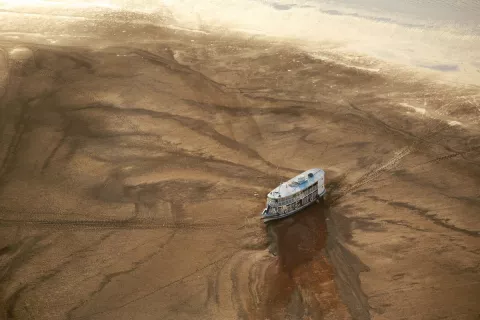
Health
Indigenous communities are also likely to see greater health insecurity. Disturbances in highly biodiverse ecosystems facilitate the growth of new human infections, as we all now know. Compounding this, certain plants and animals that are crucial to traditional remedies have already become harder to find due to deforestation. Moreover, water quality is expected to decline by roughly 25% due to droughts and increased erosion, increasing Amazonian health insecurity. For the rest of the world, deforestation will retard the medical advances the Amazon’s biodiversity has fostered.
Other economic losses
Those in the region will feel a wide range of other impacts:
- soil nutrients will be lost through erosion;
- rivers will cease to be navigable due to drought, sundering key transport links;
- cities will struggle under the weight of increased migration from former Amazon inhabitants;
- recreation and tourism income will be lost;
- perhaps as much as US$2.2 billion in net sustainable timber revenue will also vanish; and
- floods will increase, with all manner of concomitant harms.
Perhaps the single biggest economic shock will come from the loss of hydroelectric power capacity, following a collapse in the quantity of water. If the tipping point is passed, power generation potential will decline to almost 70% below its maximum. Normal production will drop by 62% for most of the year. This will substantially raise the cost of business, with price increases and job losses an inevitable result. Many homes will find power either inaccessible or beyond their means. The shock will help push at least 171,000 more people into poverty across the region.
Adaptation and mitigation
All studies agree that mitigating deforestation comes at a much lower cost. Similarly, adaptation is well worth the effort and if indigenous knowledge is taken into account, the cost will be lower still. The extent of the harms and insecurity that Amazonian Peoples and the rest of the world will face depends enormously on the extent of these efforts.
Open research questions
Looking ahead, a much more robust account of the Amazon’s ecosystem services, and their value, is needed in order to properly assess the region’s human and economic vulnerability. Reliable figures are not available for many significant factors; ecotourism, for example. More refined data on job losses, health impacts, and excess deaths are also needed, while little or nothing has been done on the cultural and identity value of the Amazon. Bringing home the harms of tipping points to citizens requires figures with immediate impact and intuitive appeal. International organisations, research funding bodies, and researchers themselves can certainly do more in this regard.
Dr. Conor Purcell is a climate researcher and award winning science writer. Dr. Michael Keary is a political scientist, specialising in environmental politics and political theory. The authors are the co-founders of NovaAura Research, helping NGOs and government bodies understand future climate projections and environmental policy.

